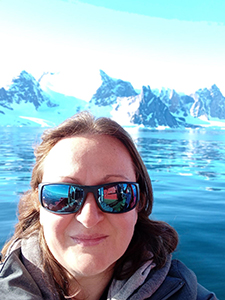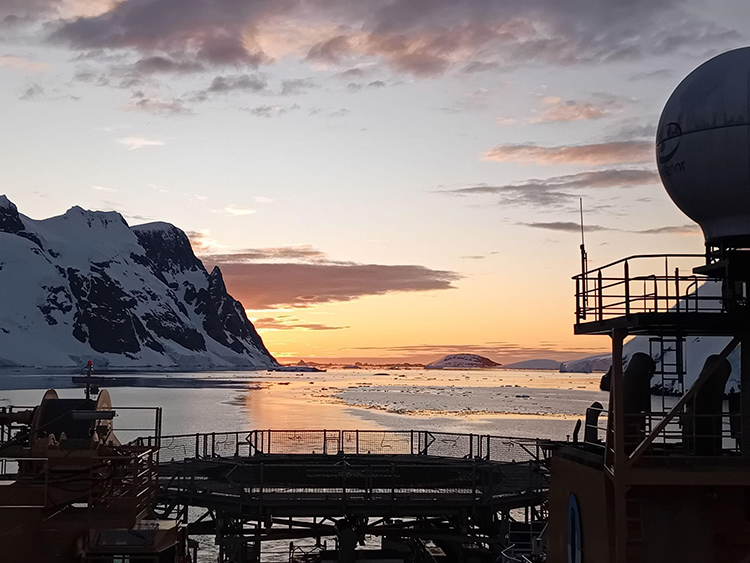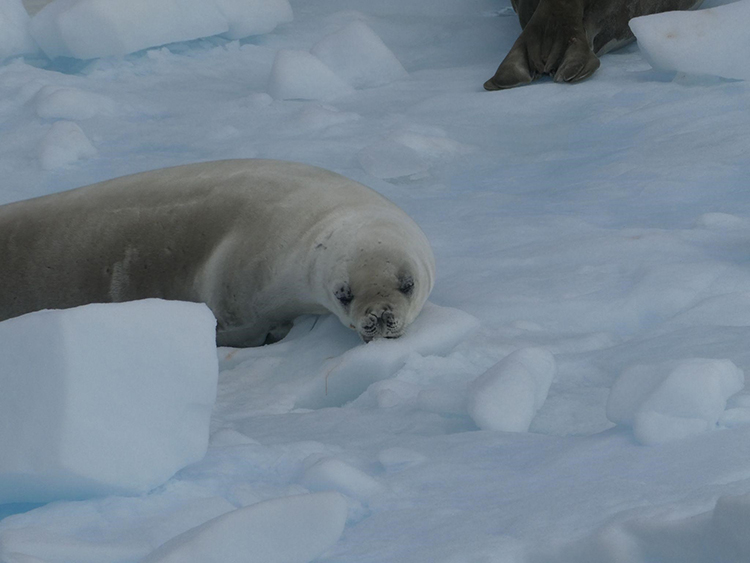Navigating the challenges and discovering solutions for environmental health along with exploring the impact of tiny particles on Antarctica and beyond.


Fay Couceiro, whose journey has taken her from the shores of marine biology to the expansive landscapes of environmental science, is a biogeochemist who studies microplastics. She has traveled all over the world to understand how microplastics affect our environment. Her work took her from the Caribbean and Southeast Asia to Africa and the UK. However, one destination remained unchecked on her bucket list—the polar regions. Pushing her boundaries even further, she has recently ventured into the icy depths of Antarctica to understand how tiny plastic particles are impacting this remote corner of the Earth.

But what exactly are microplastics, and why are they such a big deal?
We know that plastic is everywhere in our lives, from wrapping our vegetables to holding water. Since it was invented in the early 1900s, plastic production has skyrocketed. People worldwide buy a million plastic bottles every minute and use 5 trillion plastic grocery bags every year! The problem is, while plastics are convenient, they’re also harmful to our health and the environment. Plastic is lightweight, flexible, and long-lasting but here’s the kicker: plastic doesn’t just disappear. A plastic water bottle, for example, might break into smaller pieces over time, but it could take around 450 years or more to fully disappear. This means that the very first plastic items ever made are still around somewhere on Earth.
Microplastics are tiny pieces of plastic less than 5 millimeters in size that have become a widespread environmental concern. Microplastics are now found everywhere, from the Antarctic snow to remote deserts. Even smaller nanoplastics float in the air we breathe and the oceans we fish in. They can originate from the breakdown of larger plastic items due to exposure to environmental factors like sunlight and water. The primary materials making up microplastics include polymers like polyethylene, polypropylene, and polystyrene, which are commonly used in the production of various plastic products. Despite their size, microplastics pose significant threats to ecosystems and human health.
So, back to Fay’s Antarctic adventure. Recently, she got a chance to study microplastics in Antarctica on a Royal Navy ship, the HMS Protector. Contrary to expectations, the Antarctic summer wasn’t as freezing as one might imagine, with average temperatures hovering around 33–36°F (1–2°C). “It was the summer and it was not nearly as cold as you would think it would be. I actually went outside on deck in a thermal and a jumper some days. When there’s no wind it is about one degree,” says Fay.

But despite the milder weather, it was an adventure nonetheless. The Royal Navy provided everything needed for the research, making it a unique opportunity. Here, she collected diverse data, focusing on pollutants like nutrients, heavy metals, and microplastics. However, collecting samples in Antarctica posed challenges. The collection process involved a meticulous balance of technology and simplicity. The water samples were obtained with buckets and bottles, but specialized tools such as plankton nets and sediment grabs were used to ensure accurate sampling of microplastics without contamination from the ship’s materials.
Now, why is studying microplastics so crucial, you ask?
Well, because they’re everywhere, and their presence raises concerns about their impact on wildlife and human health. These tiny plastics may seem insignificant, but their omnipresence is cause for alarm. Through her work, Fay hopes to shed light on the pervasive nature of microplastics and inspire action to mitigate their impact. So, the next time you unwrap a plastic package or sip from a disposable water bottle, remember Fay’s Antarctic adventure and the vital importance of understanding the hidden world of microplastics.
Microplastics are more than just small plastic!
Surprisingly, even though we produce millions of tons of plastic each year, we know very little about the health effects of microplastics. “The smaller the particle, the more damage it can do,” says Fay. Fay states that these microplastics can also carry chemicals from the environment, making them harmful when animals eat them. In aquatic invertebrates, the impact of microplastics is alarming. They contribute to a decline in feeding behavior and fertility, impede larval growth and development, elevate oxygen consumption, and stimulate the production of reactive oxygen species. Fish, too, face detrimental effects, including structural damage to the intestine, liver, gills, and brain. Microplastics can disrupt metabolic balance, alter behavior, and affect fertility in fish, with the severity of these consequences depending on particle size, dosage, and exposure parameters.

Fay also found that bacteria stick to microplastics, creating a slimy layer called a biofilm. If that biofilm contains pathogens, it can harm marine life. She wants to figure out how much harm microplastics can cause and how to stop it. Understanding the intricate web of harmful effects caused by microplastics is crucial for developing comprehensive strategies to mitigate their impact on both human health and aquatic ecosystems.
Now, we cannot completely neglect plastics. Since their invention over a century ago, plastics have become part of our daily lives. “I genuinely don’t believe we will eliminate all plastic because it is a ridiculously useful material,” says Fay. But we make and use so much plastic that plastic pollution is now a big concern. While some plastics can be recycled, others pose real challenges to the recycling process. Of those plastics that are easy to recycle, few are considered feasible. Most are thrown into landfills, where they break down over time into smaller pieces. These have seeped into our oceans and waterways, so tiny plastic bits are showing up in some seafood. And when we wash fabrics made of plastics like nylon or polyester, plastic bits can blow out of our dryers, adding to air pollution. Scientists have found microplastics in human blood, lungs, guts, and feces. They’ve also been seen in breast milk!
Good and Bad Plastics
“So, what’s the concentration of microplastics that poses harm to either humans or ecology, and how close are we to that threshold?” Fay inquires. “Let’s say it’s 100 microplastics per liter that causes problems, and we’re currently at 50. How do we ensure we don’t reach 100? That’s a tremendously challenging question,” Fay adds. She stresses the importance of removing large plastics before they break down into microscopic particles, as oceanwide filtration would be impractical. Larger pieces of plastic in the sea or on land become brittle and gradually break down. This is due to sunlight, oxidation, or friction, or by animals nibbling on the plastic. This plastic breakdown process goes on forever, although the speed depends on the circumstances. There are beaches where you not only see large pieces, but also countless fragments, colored or faded, and the smallest pieces can no longer be distinguished from grains of sand.
Now, we know that we could never completely eliminate plastic use, and we shouldn’t try to. What’s interesting is that scientists often study bigger pieces of plastic because it’s easier, even though the small ones might be causing more damage. It is, therefore, necessary for us to understand the composition and recyclability of different types of plastics and how essential it is for effective waste management and environmental conservation efforts. There should be awareness about good and bad plastics in the community. Fay believes that when people know more about microplastics, they care more. She reminds us that simplifying the types of plastics we use and focusing on the ones we really need can really make a lot of difference. This care can lead to changes in rules and policies. “We have had engagement with policymakers and are working with our policy groups,” says Fay. Fay has talked to important people who make decisions, hoping to influence them with her research.
So, fixing plastic pollution isn’t as simple as just picking up trash. We need to understand all the ways plastic harms the environment and come up with smart plans to stop it.
What Does the Future Hold?
“We’ve seen a significant rise in Antarctic tourism over the past three decades, with the number of visitors doubling each decade. While this might initially sound impressive, it’s also a cause for concern. Managed properly, ecotourism can bring substantial benefits, especially if visitors become advocates for preserving Antarctica. However, if large cruise ships fail to follow regulations and leave behind pollutants like metals, microplastics, and sewage, it poses a serious problem. We need effective monitoring and enforcement to maintain the pristine condition of this fragile environment.”
–Fay Couceiro
International cooperation and collaboration are crucial in Antarctica, where tourism is increasing and environmental impacts are a concern. Microplastics harm Antarctic life by entering the food chain, affecting the health of organisms and making them less able to cope with climate change.

Fay delved into ongoing research efforts, shedding light on the exploration of enzymatic breakdowns as a promising solution to the microplastic issue. “There are chemical methods available for eliminating plastics, but they tend to be costly and not very efficient, especially when dealing with microplastics,” says Fay. However, she emphasized the considerable challenge of scaling up these processes effectively. “We have enzymes that can eat plastic and separate them into their smaller monomers. But how do we do that on an industrial scale? And how would we do that with a mix of them? We can’t separate them out into the perfect laboratory conditions. So how do we scale that up?” asks Fay. Moreover, she also underscored the critical importance of monitoring human activities, particularly those associated with cruise ships, in delicate ecosystems like Antarctica. This interactive approach not only engages but also prompts reflection on our collective responsibility to safeguard these precious environments.
Fay hinted at exciting future endeavors, including a groundbreaking comparative study between the Arctic and Antarctic regions. Such an exploration promises to unveil crucial insights into how human activities impact these pristine polar environments. As we delved deeper into the conversation, it became evident that Fay’s passion lies in unraveling the intricate relationship between human actions and environmental health. She articulated a pressing need for a paradigm shift, urging us to move beyond short-sighted monetary gains and prioritize the long-term well-being of our planet.
But what exactly is at stake? Consider this staggering statistic: people worldwide purchase a million plastic bottles every minute, while a mind-boggling 5 trillion plastic grocery bags are consumed annually. These numbers paint a stark picture of our reliance on plastic convenience items. Yet, convenience comes at a cost—one that’s detrimental to both our health and the environment.
It’s a problem exacerbated by an industry that thrives on the production and distribution of plastics, raking in over $600 billion annually. This financial incentive fuels a cycle of consumption, production, and waste that threatens the very ecosystems we depend on. However, amid the grim realities, Fay’s work offers a beacon of hope. By unraveling the mysteries of microplastics and shedding light on their impact, she empowers us to make informed choices for a cleaner, healthier planet. Her optimism stems from the belief in humanity’s collective ability to address environmental challenges through collaborative efforts.
As we reflect on Fay’s insights, it becomes clear that the microplastic challenge isn’t just an isolated issue. It’s a symptom of a broader problem that requires urgent attention. It’s a call to action, urging us to rethink our consumption patterns, advocate for sustainable practices, and hold industries accountable for their environmental footprint. In the end, Fay Couceiro’s work serves as a reminder of our shared responsibility to safeguard the planet for future generations. It’s a reminder that by working together, we can pave the way towards a more sustainable and prosperous future.
Get Involved
Contact the Midwest Big Data Innovation Hub if you’re aware of other people or topics we should profile here, or to participate in any of our community-led Priority Areas. The MBDH has a variety of ways to get involved with our community and activities, including our cross-sector Water Data Forum webinar series, which recently had a session on microplastics and AI.
The Midwest Big Data Innovation Hub is an NSF-funded partnership of the University of Illinois at Urbana-Champaign, Indiana University, Iowa State University, the University of Michigan, the University of Minnesota, and the University of North Dakota, and is focused on developing collaborations in the 12-state Midwest region. Learn more about the national NSF Big Data Hubs community.
